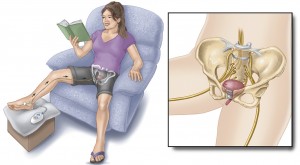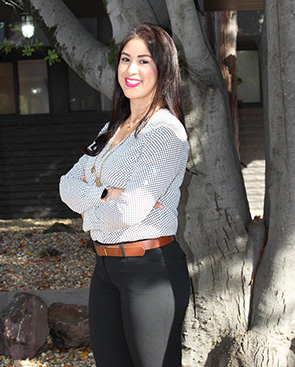PTNS

A female patient is using Percutaneous Tibial Nerve Stimulation (PTNS) to help control her urinary incontinence. An electrode is placed only at the ankle area.
Percutaneous Tibial Nerve Stimuation (PTNS) is a low-risk, non-surgical treatment. PTNS works by indirectly providing electrical stimulation to the nerves responsible for bladder and pelvic floor function. During PTNS treatment, the patient’s foot is comfortably elevated and supported. Also during treatment, a slim needle electrode is placed near the nerve at the ankle known as the tibial nerve. A device known as the Urgent PC Stimulator is connected to the electrode and sends mild electrical pulses to the tibial nerve. These impulses travel to the sacral nerve plexus, the group of nerves at the base of the spine responsible for bladder function.
By stimulating these nerves through gentle electrical impulses (called neuromodulation), bladder activity can be changed. Because this change happens gradually, patients receive a series of 12-weekly, 30-minute treatments. After the 12 treatments, when the patient’s response to therapy is assessed, occasional treatments may be needed to sustain symptom improvement.
PTNS is a form of electroacupuncture. You can find out more about this by reading our information on acupuncture.
Who Can Benefit from PTNS Treatment?
This therapeutic treatment is for patients experiencing overactive bladder (OAB) symptoms of urinary urgency, urinary frequency and/or urge incontinence. PTNS has been approved by regulatory agencies outside the United States to treat fecal incontinence, but has not been approved for this usage in the US at this time. PTNS is generally used after behavior modifications, Kegel exercises and failure of medications.
Who Cannot Use Percutaneous Tibial Nerve Stimulation (PTNS)
This therapeutic treatment is for patients experiencing overactive bladder (OAB) symptoms of urinary urgency, urinary frequency and/or urge incontinence. PTNS has been approved by regulatory agencies outside the United States to treat fecal incontinence, but has not been approved for this usage in the US at this time. PTNS is generally used after behavior modifications, Kegel exercises and failure of medications.
Positive Aspects of Percutaneous Tibial Nerve Stimulation (PTNS)
- Studies report that 60 – 80% of patients improve with PTNS.
- PTNS is non-surgical and a low risk option. It does not require an implant or have lingering side-effects.
- This therapy is perceived as relatively painless. Patients typically describe the sensation as a “tingling” or a “pulsing” in the foot or ankle.
- Patients who respond to initial series of treatment can usually sustain symptom improvement with an occasional treatment.
Things to Remember
- PTNS requires patients to commit to 12-weekly, 30-minute doctors visits. It may be five to six (5-6) weeks before a patient starts to see improvements. In one study of successful PTNS patients, symptoms improved between 2 – 12 weeks.
- As with all OAB treatments, results for individual patients will vary.
- Your health care provider will work with you to minimize any discomfort during treatment. You may experience temporary mild discomfort or redness at or near the stimulation site. However, no major adverse reactions have been reported to date.
Medical Reviewer: Leslie Saltzstein Wooldridge, GNP-BC
Ms. Saltzstein Wooldridge, GNP-BC, is Director of the Adult Bladder Control Center, Mercy Health Partners, Muskegon, Michigan USA. She her Master of Science degree in nursing administration, critical care nursing and postgraduate certification as a Geriatric Nurse Practitioner from Marquette University, Milwaukee, Wisconsin. She is recipient of the 2009 National Association for Continence Rodney J. Appell Continence Champion Award. Ms. Wooldridge has published in multiple refereed journals. She authored the Genitourinary chapter in The Nurse Practitioner in Long Term Care: Guidelines for Clinical Practice (2007). She has lectured throughout the United States on geriatrics, urology and clinical practice.



